While we wait for the tyres and spares to arrive in Windhoek Ruedi tries to fix our broken heater.
Even though the sun shines the wind is bitterly cold; it would be nice to have the heater going again ....
The heater is full of grime and Ruedi gives it a real good clean .... sadly a very fine sieve that is used to distribute the diesel is also "cleaned" away .......
which is the end of the heater for this trip .....
Spares in Africa .... what's that???
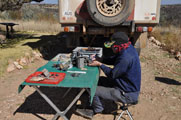
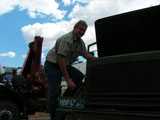
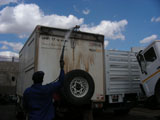
Then the tyres arrive and the last repairs are done in the Namib Truck Centre by Kai
and his crew.
The tyres are of the wrong size and specs (285/70 R19.5 unstead of 305/70 R19.5)
The OKA even gets a good wash!
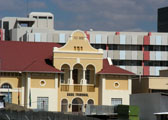
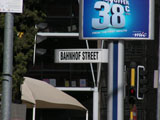
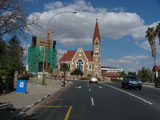
On Wednesday, July 13, after a filling up with goodies at the SuperSPAR we finally leave Windhoek.
As we don't like bitumen we pick manly small gravel roads to take us north.
From the C28 we take the D1958 which has been damaged a fair bit by the rains ..... or at least on the shire of Windhoek side.... because as soon as we cross into the shire of Okahandja side he gravel road is freshly graded and in very good condition.
So we quickly make ground and via the D1967 reach Wilhelmstal.
There we head west the B2, the main bitumen road to Swakopmund.
The road is under construction but is managed well, not like in South Africa:
The old road has been widened thus the traffic can circulate normally and no waiting is necessary.
Also the way they build the road seems to be a bit more professional than in South Africa.
In Usakos we take the D1935 and then the D1937 to Ameib Ranch.
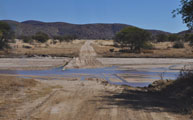
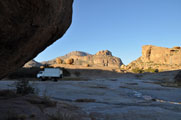
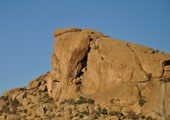
We visit the Bull's Party rock formation ... but somehow we don't find anything extraordinary there except a rock which looks like an elephant.
So we head to the camp and settle for the night.
Since the "death" of our heater we use the diesel stove as heater.
But today is the first night in weeks where we don't miss the heater.
Lovely!
On Thursday morning it is already warm when we get up.
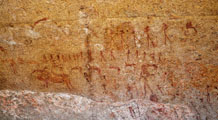
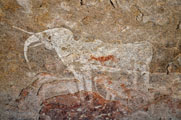
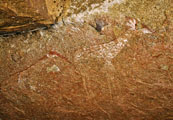
We visit Philip's Cave and the San paintings but are a bit disappointed about their quality.
Probably already too many have touched them or even poured water on them so they look better on the pictures .....
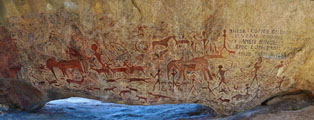
.... the copy that is at display is much better .....
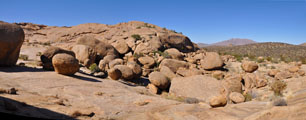
Then we visit the Bull's Party rock formation again but again don't see them .... not enough fantasy .....? We don't know.
We get back onto the D1905 / D2306 and head north.
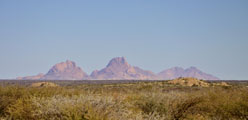
In the distance we see the Spitzkoppe.
Depending on the angle that one sees it looks like the Matterhorn in Switzerland .... but we did not take a picture then, sorry.
We have to pass the Omaruru River in Okombahe again and are surprised to see that it is dry now.
Just two weeks ago the water was still flowing!
We take the D2344 in westerly direction.
In Ozondati we see the elephant warning sign again.
The creek leads to the Ugab River and apparently the elephants make it up to the village every so often.
The telephone poles are surrounded by a circular area of rocks to protect them against being "vandalised" by the elephants.
We see the same in the following villages.
We seem to be reaching areas with more water.
The vegetation changes and the thorn acacia bushes are now less frequent and trees and shrubs are growing well.
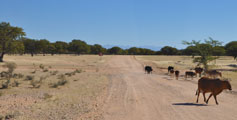

Also the droves are larger and contain not only goats anymore but more and more cattle.
We pass through the Onverwag Herero Community where Herero Ladies in their typical long Victorian gowns and headdresses sell their souvenirs.
They must be hot because by now the thermometer has reached 28.5°C ......
As we are not interested in buying souvenirs we also don't take their pictures.
We try to reach the Burnt Mountain but Susi enters "shortest distance" in the GPS and are therefore routed onto an off-road track.
It has not been driven much lately and on the map we see that it will be very rough later on.
So the visit is postponed o tomorrow and we set up camp out bush ..... or rather "out savannah" .......
Ruedi gets busy with the OKA and Susi studies the guide books and maps to define the route for the next few days.
As we sit down for dinner we hear the sound of an animal.
It starts like laughing and ends like a small dog's yelp.
We wonder what it could be but for the moment have no clue.
We sleep with some windows open hoping to hear animals around the OKA but we don't hear a bit ..... even though in the morning we see many track on top of the ones we had left during the day .....
On Friday morning we are on our way shortly after 8 AM hoping to reach the Burnt Mountains in good light.
We head back to the D2612, and then take the D3254.
There is a fair bit of traffic.
We feel that this is a touristic area and close to a major attraction, Etosha!
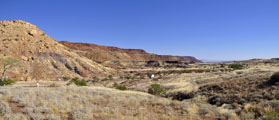
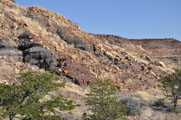
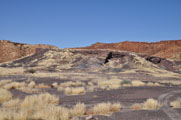
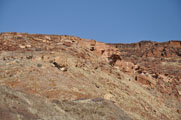
The colours of the Burnt Mountains are very nice.
It must be very pretty to see a sunrise here.

Next we stop at the Organ Pipes.
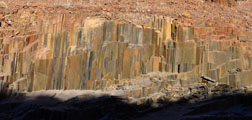
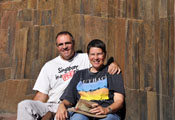
They are not large but they have some nice colours and interesting shapes.
As we leave Ruedi has some problems getting the OKA into first gear.
There seems to be a general problem with changing gears .....
Shortly after when changing gears he is not able to get any gear in at all.
Hmmmm .... what could this be?
Ruedi guesses the clutch.
But we only had a new one fitted in November last year!
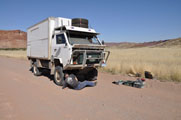
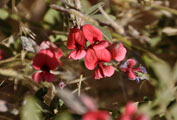
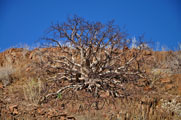
Ruedi gets his tools out and gets into his "favourite position": underneath the OKA ........ while Susi goes for a walk
He finds clutch fluid all over the place.
Luckily he can tighten the fixture and the leak is sealed.
So we are off again.
Note: Ruedi later on states that this leak must have been present for a long time as shifting gear has not been this easy for a long time.
Now Susi should be able to shift gears again and therefore also to drive the OKA again ......
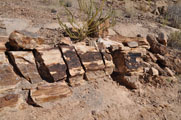
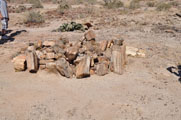
Then we get onto the C39 towards Outjo and visit the Petrified Forest.
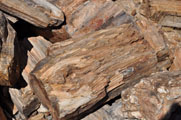
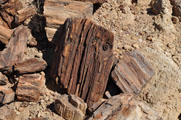
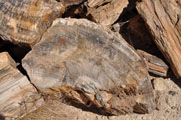
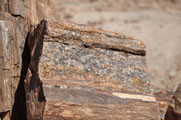
They have some excellent pieces of petrified trees.
One can even see he bark and the annual growth rings!
The guide is really funny.
He also tells us that it is a community run project and the money goes back into the community.
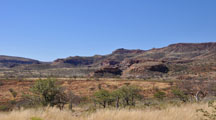
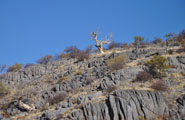
In Khorixas we reach the bitumen and stay on it until we deviate onto the D2743 in southerly direction.

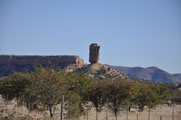
The valley has a few formations like Monument Valley.
It also has a single large column called Vingerklip.
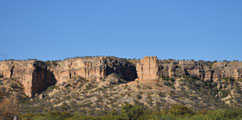
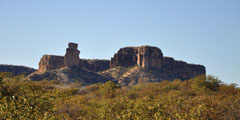
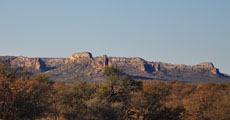
On the other side of the valley the Ugab Terraces look stunning.
We decide to follow the valley east on the D2752.
All at the end, where the gravel road turns north there is another section of Terraces, very pretty indeed.
Then we reach the bitumen again and it is time to pump up the tyres until we reach Etosha.
We stay in Outjo in the Ombinda Country Lodge and enjoy the comfort of Internet and proximity to town and the Outjo Bäckerei, a German bakery ......
Saturday and Sunday pass quickly with Ruedi working on the OKA and Susi on the web page.
On Monday morning it is very cold again with just 1°C ...... gone are the few warm days we had ..... but the sun is shining and at least the days are a bit warmer as they were further south!
We head north on the C38 and enter Etosha Nationals Park through the Anderson Gate.
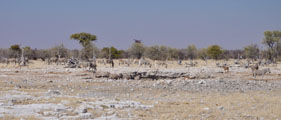
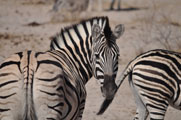
Right after the gate we see lots of Zebras, Springboks, Gnus, etc. at the Ombika waterholes.
We check at the camp site then head west.
Here too there are plenty of animals probably because of the waterhole at the camp.
The Leeubron waterhole is dry.
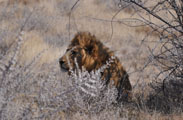
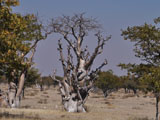
Shortly after we see two cars .... waiting ...... we stop too and then see the Lion under the bush.
We would not have seen it .....
We continue on to the "Märchenwald", a group of Moringa trees (Moringa ovalifolia).
To us the look similar to Boab trees.
The San tell a similar story about them as the Aboriginal do about the Boabs:
The Moringa trees were thrown out of paradise and landed on earth ..... head down ........
Apparently it is unusual to see so many of them in one spot ......
As we get closer to the Charl Marais Dam there are more and more animals.
We even see fresh elephant dung.

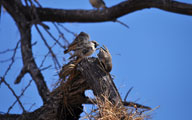
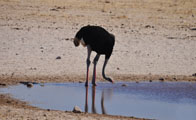
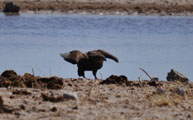
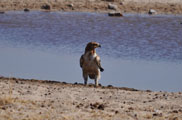
At Ozonjuitji m'Bari there is quite some activity.
Ostriches are drinking, two eagles are sitting there, one of them later on also gets a drink, Oryx and Zebras ......but the elephant is nowhere to be seen ......
We head back and check out the location where we had seen the lion but it is gone ......
We decide to head back and shortly after the dam find a group of Springboks ..... in the middle of the road ...... not really interested in moving away ...... so we wait and watch them.
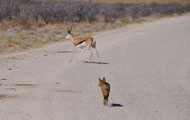
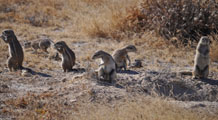
Then a Black-backed Jackal approaches them but they don't even look at it.
So Springbok is also not on the Jackals menu ......
Next we head north to the Okondeka waterhole.
On the way we see some more Jackals.
A group of Giraffes decides to cross the road directly in front of us ..... so we wait again and watch them as they elegantly walk away.
We did not know that they are amblers.
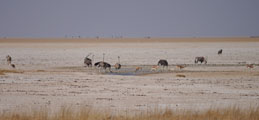
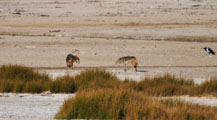
The Okondeka waterhole has too much water resulting in a small puddle of water having formed
further away from the car park.
Sadly the animals use that one for their drinks and don't come to the waterhole.
We can watch a Black-backed Jackal approaching the waterhole.
Then a second one appears.
Jackal 1 is not aware of Jackal 2 but Jackal 2 watches Jackal 1 very carefully.
Then Jackal 3 appears from behind the OKA and also trots towards the water.
Jackal 1 is not aware of any of this and leaves the waterhole.
Jackal 2 sees Jackal 3 and vice versa.
They seem to be interested in each other ..... Jackal 2 drinks but keeps an eye on Jackal 3.
Jackal 3 goes directly in direction of Jackal 2, and then poops.
Jackal 2 comes closer, has a look and sniff .... is not interested and walks away ......
That was an interesting intermezzo.
We decide to head back to the camp.
As we leave a Jackal runs ahead of us on the road ...... over the whole day today we must have seen some 10 – 15 Jackals.
On the way to Wolfsnes waterhole a squirrel sits on the road, directly on our side of the road and does not move.
Ruedi slows down and drives so close that we cannot see the squirrel anymore from the driver's cabin.
At the end Ruedi has to fully stop the OKA as otherwise he would have run the squirrel over ..... and wait while the squirrel eats .....
Only when another car comes from the opposite side the squirrel finally decides to leave the road.
Then we head back to the camp.
There is not much happening at the waterhole just a group of Black-backed Jackals is playing around and chasing each other.
So after watching a pretty sunset we decide to have dinner first and come back later.
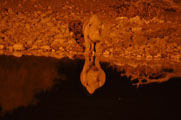
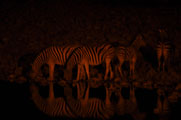
When we reach the waterhole a Rhino is having a drink.
Some Zebras join and Black-backed Jackals play around them.
A Small Spotted Genet promenades along the wall just below the watching audience.
It is not disturbed at all by all the people and takes its time to catch a mouse and eat it before disappearing into the dark again ......
Then one of the Jackals starts howling.
Another one replies.
Then we hear some howling from the camp too ...... on the walk back to the camp we see Black-backed Jackals all over the place .....
On Tuesday right after dawn we go down to the water hole again.
But it is very quiet; just a few Black-backed Jackals are present.
Then one of them starts howling ..... a second one replies ...... some more join in from where the camp area is ...... fascinating ......
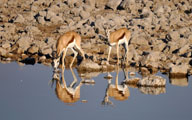
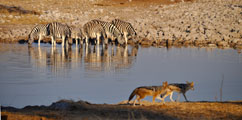
After breakfast we try our luck again.
Now the herbivores are coming for their drink ..... Zebra, Springboks ...... large flocks of Guinea Fowl ..... and the ever present Black-backed Jackals ......
Today we have to get to the other end of the Etosha National Park to the Namutoni Camp.
This means a fair bit of driving and not much time to stop at too many waterholes.
We still have enough time to see a lot .....
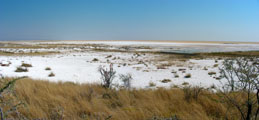
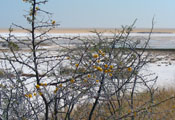
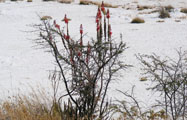
The Etosha Pan still has a lot of water.
Amazingly flowers are blooming along the salty water.

Flocks of Greater Flamingos feed along the shore.
After checking in at the Namutoni Camp the plan is to drive clockwise around the Fisher's Pan in the late afternoon so we get nice pictures of Giraffes in the sun set.
As we still have a bit of time we decide to visit Tsumcor waterhole first.
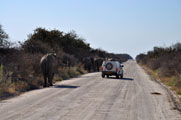
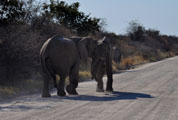
On the way we pass a group of elephants.
They are walking on the road and around the cars.
Ruedi feels a bit uncomfortable with that many female elephants and their babies around him and the other cars ......
Some young ones get rowdy and push each other around on the road.
The elephants are only about 1.5 km away from the waterhole and walking in that direction.
So we head there to get a good spot before they arrive.
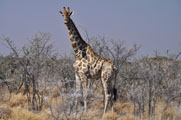
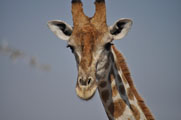
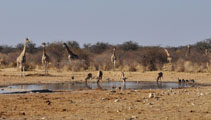
At the Tsumcor waterhole we can watch Giraffes drinking.
They look really awkward because they have to get their neck past their long legs which is a bit tricky.
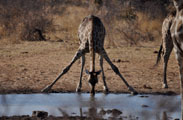
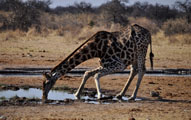
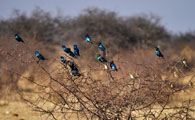
Male and female have a different technique: the female makes the splits and the male bend their knees.
Then the elephants arrive.
We can hear them long before we can see them.
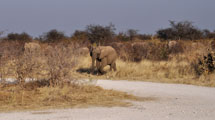
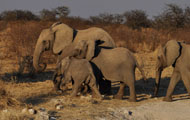
Again we are surprised how well they blend in with the bush; one can only see them when they are very close.
More and more arrive, all females with their babies and young animals ......

At the end there must be 40 – 45 animals!
Amazing!
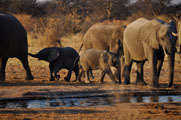
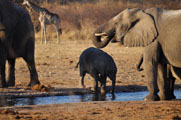
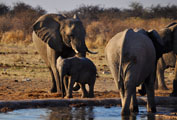
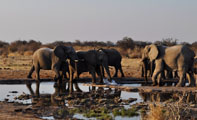
We watch them and enjoy their playful behaviour.
Again some young bulls
(maybe the same ones that were fooling around on the road?) play with the water, blow air into it and spray around.
We could have watched for ever but time runs out, we have to be back at the camp before the gate closes ....
Full of impressions of this impressive sighting we leave and head back.
On Wednesday, July 20, we leave the camp early and settle down at the Chudob waterhole for breakfast.
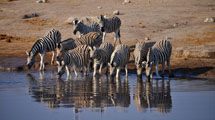
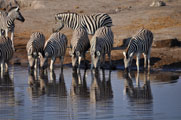
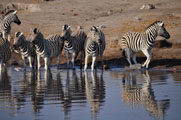
Soon the animals start arriving ..... herds of Zebras, Impalas, Gnus, a few Oryx', Guinea Fowl ......
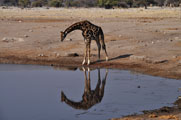

A male Giraffe comes to the waterhole and looks like being thirsty but somehow it is impaired and cannot get down to the water.
All morning it walks around the waterhole and tries and tries .....
Later on it even tries it the "female" way by trying the splits but just does not (yet) get down far enough to reach the water ..... let's hope it will make it .....
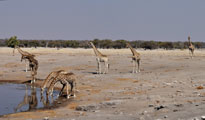
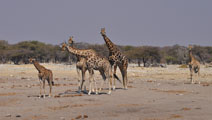
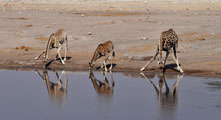
The procession of animals is never ending ......
At one time we see a least 13 Giraffes!
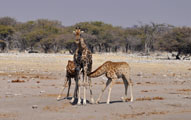
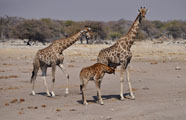
Some baby Giraffes suckle.
We wonder how old they might be ....
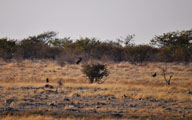
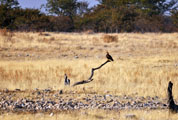
During the morning various eagles and vultures arrive and settle down in various trees.
What are they waiting for ........ the Giraffe ......?
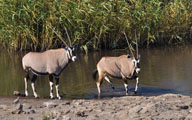
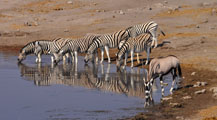
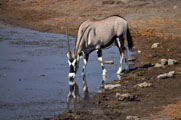
Oryx antelopes (or Gemsbok as they call them in Southern Africa) come for a drink.
We think that they must be some of the prettier animals we know.
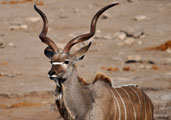
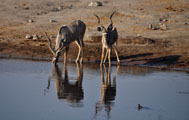
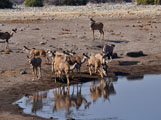
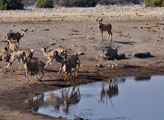
Some male Kudus check out the water .... then the females follow.
An Oryx decides that it does not like the Kudus and scares them away .... so Oryx has the higher pecking order than Kudu ....
Some male Kudus have a fight ......
A Jackal arrives and all Guinea Fowl disappear ...... so now it is Jackal feeding time and the Guinea Fowl are on his menu .........
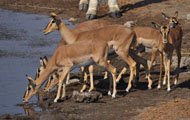
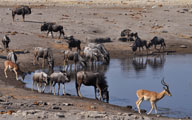
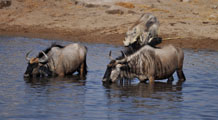
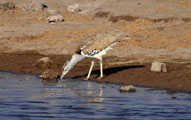
Impalas, Springboks, Gnus, a Kori Bustard ...... there is a lot of activity at the waterhole.
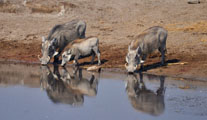
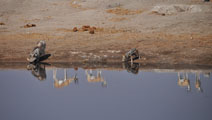
... the Warthog family with the young one ......
Warthogs ... at least not the adult ones .... don't seem to be in the Black Backed Jackal's food chain and drink peacefully side by side.
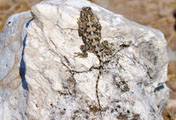
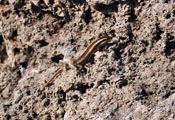
A lizard lazily lies in the sun, while another one frantically tries to get rid of its old skin .....

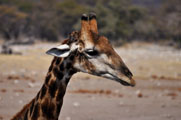
The lonely Giraffe still walks around the waterhole and watches other animals.
Every so often it tries to imitate their way of drinking.
As it copies a female Giraffe it almost reaches down to the water ... but only just .....
When it is time for us to leave the Giraffe comes close to the OKA and looks at us with the large, heavy lashed eyes ...... as if it was saying "You know what my problem is. Can't you help me???"
It is very hard not to go down to the waterhole and get a bucket full of water for the Giraffe .... but it would only have extended its agony by another day or two ..... we have to let nature decide what the future of the Giraffe will be .... not us ..... which is hard .....


Later on we dislocate to the Halali Camp.
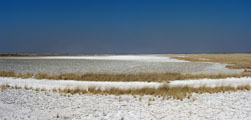
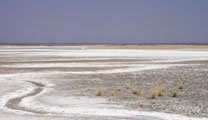
We pass the Etosha pan. the water is already drying up here and the lake shows its white salty surface.
On the way we visit a few waterholes to pick one for tomorrow's breakfast.
At the Halali Camp we set up camp and Ruedi has a look at the breaks.
Susi heads down at the local Moringa waterhole.
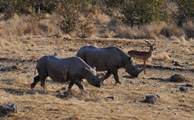
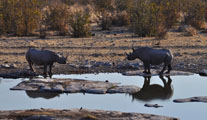
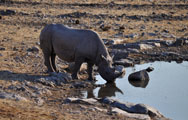
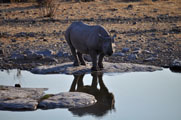
Shortly after she arrives two Rhinos walk in for a drink.
She rushes back to Ruedi tell him about the visit. and that he should come and watch too
But he has got all the tools out and does not fancy leaving the OKA that way.
Well, next time ......
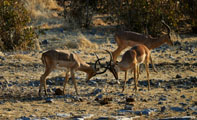
Once the Rhinos leave some young Impalas display some playful fighting.
On Thursday morning we head over to the Rietfontein Waterhole for breakfast.
In the sightings book we had seen a note that there had been a pack of 7 lions at the waterhole the day before.
We hope that they are still there.
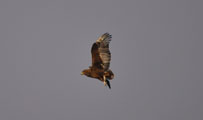
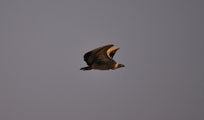
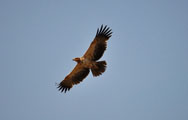
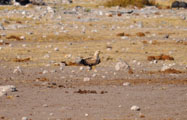
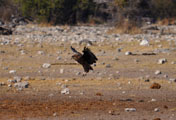
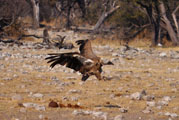
When we arrive we see many vultures and raptors busily eating the rest of a kill.
Hmmmm ..... looks like the cats were here last night too ....
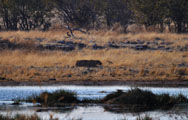
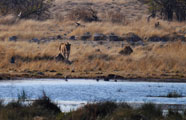
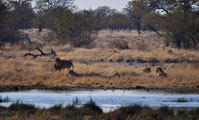
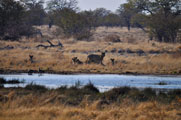
Then we spot them.
The lions rest close to the waterhole and look really full ......
After a while we get the idea that we could "shock" them with the roaring of the lion we had seen in Karongwe during our course.
Quickly we load he sound file onto the iPod and then play it.
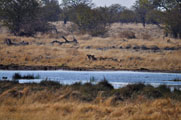
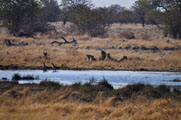
The reaction is immediate.
Seven heads fly up and a young male even gets up.
Wow!
Click here  to view the movie. to view the movie.
Due to the presence of the lions the other animals are really cautious and do no really dare to come close to the water for a drink.
Just some Kudus very carefully come closer, two watching one drinking ..... then retrieve again .....

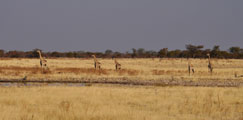
Large herds of Zebras, Springbok and Impalas start massing up and get nervous.
Then the lions leave the waterhole and settle down in the shade of the trees for a siesta.
Now the waterhole gets really busy and there is a lot to be seen.
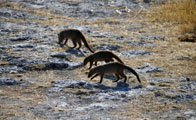
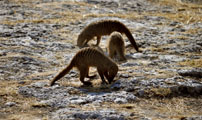
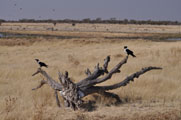
Some Banded Mongoose dig for food, some Pied Crows sing a bit ..... time flies .....
We decide to stay here for the rest of the day and hope to get a second chance with the lions.
We know that they are still there because Susi works on the movie from this morning lion "shock" and when she plays the sound a bit loud the lions get up and start looking for the male making the sound .....
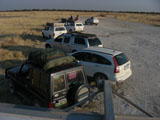
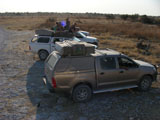
We are not the only ones waiting.
People have left their vehicles and settled on the roofs of their cars to get a better view.
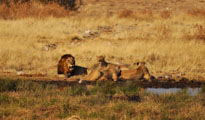
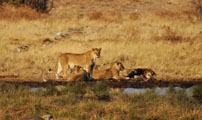
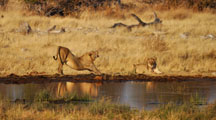
In the late afternoon the lions start getting restless.
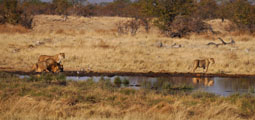
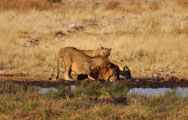
Then they walk down to the waterhole for a drink.
What excitement!
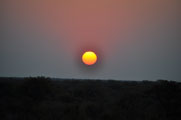
After this excellent day we head back to the camp and have a sundowner at the waterhole.
On Friday it is already time to say goodbye to Etosha National Park.
As a last treat we want to re-visit the Chudob Waterhole near the Namutoni Camp.
On the way east besides the "usual" animals we see two male elephants, a horn adder and almost drive into a rhino ......
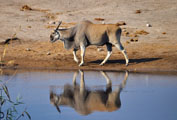
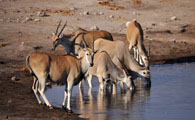
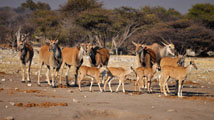
When we reach Chudob Waterhole a large group of Elands just walks toward the waterhole.
We have never seen that many Elands in one group as they normally are very shy.
They even have 3 very young ones that play around ......
We can also watch two Oryx males having a bit of a locking horns session because of a female .....
Like last time an almost endless procession of animal group coming for a drink.
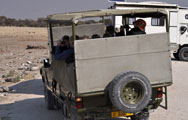
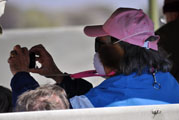
We also have some fun watching the tourists .....
Then we leave the park through the Lidquist Gate and head east and then north on to the B1, then east on the D3001 and then north on the B15.
According to the maps the bitumen road ends at Tsintsabis.
We follow the GPS and lands in the middle of the town ..... dead end ....
It used to be the road but now they have the bitumen bypass and even though first it goes in the wrong direction it is the correct road north.
The road is brand new ..... the bitumen has not yet seen too many vehicles on it ........
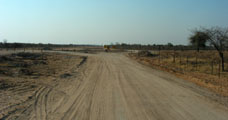
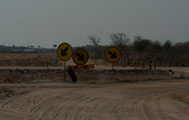
Later on we reach the construction site.
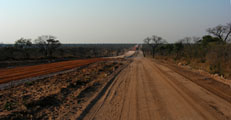
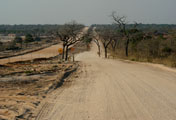
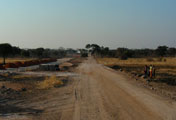
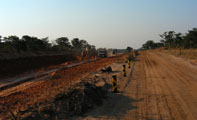
For many many km we follow the future new road on the old gravel track.
It seems that they have problems with water here every so often.
The recent rains must have pointed out the weak points of the road out to them as they are busily building overpasses and also water storage areas.
What is really interesting is to see that they separate the different layers of soil.
The top soil is paced aside and marked as such .....
Looks like they intend to restore the surface as much as possible to what it was before .....
Amazing!
Again we are surprised to see how well they build the roads in Namibia.
It is not just a bit of gravel flattened and then bitumen placed on top as it is in South Africa, no, real road beds are made first and thoroughly rolled-in.
Then we reach the veterinary check point.
The police officer that speaks English asks many questions and they shortly discuss something amongst themselves and then ask if we have a 4WD. We wonder why?
There is sand ahead ....
They decide that we have a strong vehicle and should be able to make it .... we wonder what is ahead of us ........
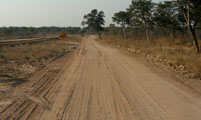
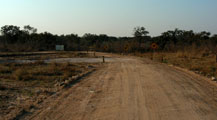
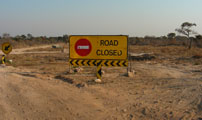
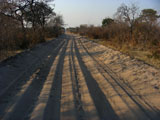
The road construction crews wave at us, the grader driver toots the horn ....
Ruedi toots back .....
......
and we have reached the end of the construction ........ from now on the track it is sandy ........ looks like overgrown sand-dunes to us.
After lowering the tyre pressure to sand the OKA nicely makes its way over the sand-dunes.
We decide to stop some 40 km south of Mpungu as further north there could be more people and it would be a bit more difficult to find a suitable spot for the night.
Here we are "out bush" and there is very little traffic.
Over night it gets amazingly cold: from the 28.5°C during the day it drops down to 2.5°C!
On Saturday, July 23, we tackle the next bit of sandy track.
It has some nasty sections with deep sand.
In the future this will be the B15 ..... but for now Ruedi has to use his skills that we don't get stuck ...... there is "reminders" of people that had to turn to nature to get out of the deep sand ......
Then we reach Katope and the gravel.
Here we see a new way of transporting goods .....
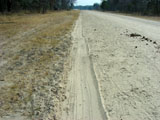
What do you think has made this track?
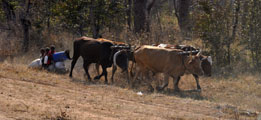
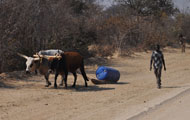
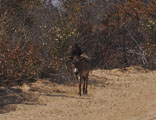
Wooden sledges pulled by oxen over the sand are used to transport anything.
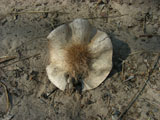
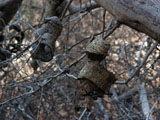
Susi also find some interesting seeds and trees.
Then we reach Mpungu and turn east onto the D3407.
It is a reasonable good gravel road leading through dry farming land.
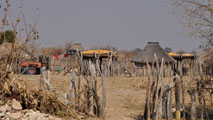
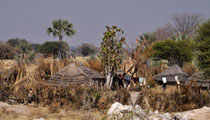
There is a lot of cattle around and people seem to be doing reasonably good.
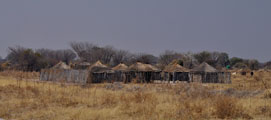
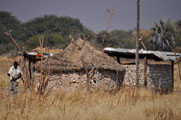
Here the houses are completely different from what we have seen so far.
They are still round but all are inside of an enclosure, a kraal.
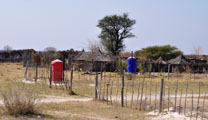
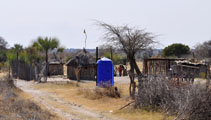
We can see that the villages have been equipped long-drop toilets.
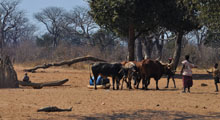
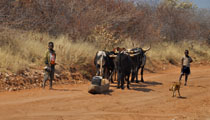
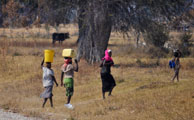
Every so often water tanks have been built and we see many sledges being led there to fetch water.
But many women still carry containers with water on their heads as it was done for a long time.
Only difference: today the containers are made of plastic ....
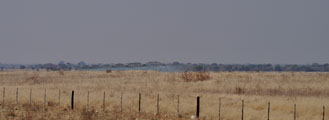
Then we reach the Okavango River and the bitumen.
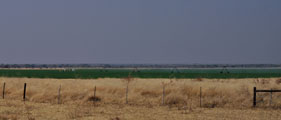
We also reach the irrigation systems. It looks odd to see the green fields after all this dryness .....
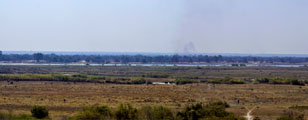
As we follow the river on the B10.
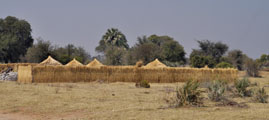
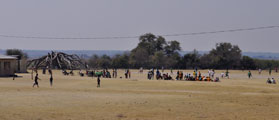
It is a densely populates area.
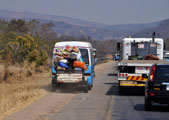
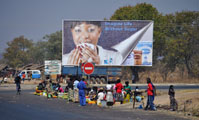
We are not used to see that much traffic and that many people .....
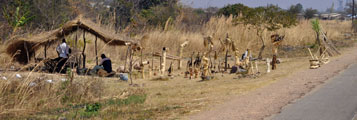
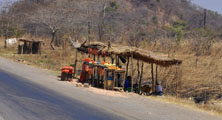
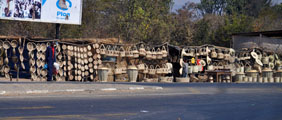
Along the road many stalls sell whatever they can produce.
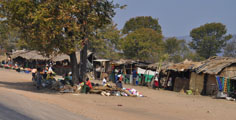
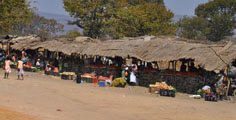
Many towns seem to be just one large stretch of stalls along the road too .... and they all seem to sell the same good.
How can they earn their living that way?
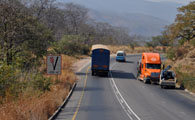
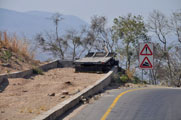
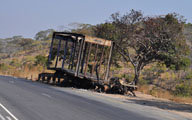
The amount of broken down trucks increases .... also the amount of "left-overs" .....
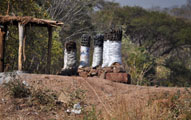
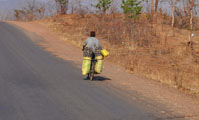
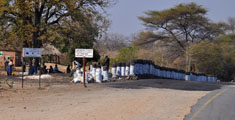
We can follow the supply chain too:
- Coal is produced and then sold along the road ... the "rebate" placed on top of the bags .....
- Traders buy the bags, transport them on their bicycles to the next pick up spot where trucks can stop where they are sold
-
Trucks come and buy the bags and transport them to the cities where they are sold to traders.
We reach Rundu and go shopping.
It is incredible busy, taxis everywhere, parked cars left right and centre, people all over the place ..... stress!
When Ruedi reverses out of the parking lot of Pick'n'Pay he hits a pole.
Quickly he security guard is here and orders him to park again and to wait until the manager is here.
He also alerts the armed response unit which arrive really quickly and park right beside us.
Then the manager arrives and Ruedi, the guard and the manager inspect the damage.
Luckily the pole is only bent and the manager decides that they will fix it themselves.
So we leave the hectic place and drive out to the Kaisosi River Lodge right at the Okavango River where we check in for 2 days.
Sadly the water of the river is already low and the hippos (for what Susi wanted to stay at this lodge ......) have already moved down the river.
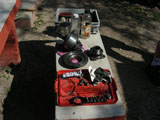
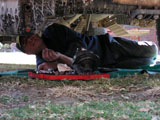
In the afternoon Ruedi tackles the task of exchanging the seal of the yoke.
It had started to loose oil but luckily we have the good seals now and can fix correctly.
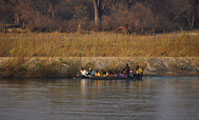
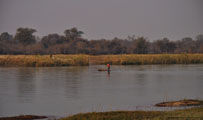
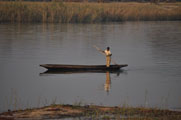
In the evening we watch the happenings along the river's edge.
The other side of the river is Angola but the border is not really a problem here, people travel from one side of the river to the other one without any passport control or whatever.
We are told that the two countries have agreed that an area approx. 30 km
wide on both sides of the river is not checked as it is mainly locals that cross from one side to the other one and back again.
On Sunday morning for the first time we hand in the washing to be done in the laundry.
It is just too hard to find a laundrette with proper washing machines and hot water.
Susi gets busy with the mozzie screen for the entry door.
We now really need it as this is Malaria territory and there are plenty of mozzies around.
Ruedi finishes the replacement of the yoke ..... let's hope that it is leak-proof now.
In the later afternoon we go on a river sunset cruise together with our Swiss neighbours Jürg and Helga.
As we are slowly but surely getting to the warmer areas of Africa we decide to have our Raclette for dinner ..... yummy!
On Monday morning we head into Rundu to stock up and then head east into the Caprivi Strip.
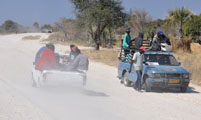
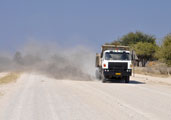
The traffic is quite interesting ....
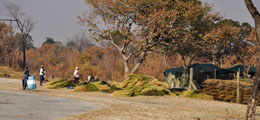
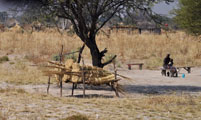
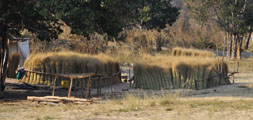
Long reeds are collected, then bundled and sold along the road.
Again we see the transport by bicycle and the collection points for the trucks.
We are told that the reeds are
in the south to thatch the roofs of the houses .... especially in tourist resorts .....
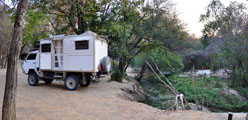
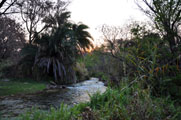
We stop at the Popa Falls or more the Popa Rapids for the night.
The camp is situated directly at the rapids.
Hippo tracks are visible on the little island opposite of the camp ......
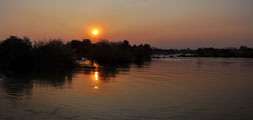
We head down to the sand bank for a very pretty sunset setting.
On the way back we are addressed by three youths along the fence.
They are collecting donations to bring them through school.
We don't have money with us so we have to deny their request.
As we walk away from the fence and think it over we realise that the entries of "donations" had all been done in the same handwriting as the paper with the explanation ...... and the entries had been fairly large, all above 120 N$ ...... and one of the youth had been wearing an ear ring with a small crystal in it ...... it all kind of adds up, too many coincidences ......
Anyway, maybe it was good that we had no money on us.
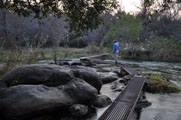
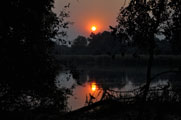
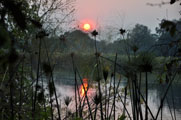
We head over to the little island on the trail and follow the various paths along the river.
It is very pretty here too but we don't dare to stay to long as the presence of hippos is very obvious and we don't really fancy to face one right on foot ....
It gets pretty fresh over night with just 1.5°C.
No wonder they say there is no Malaria because it is too cold.
We drive south to Mahango National Park.
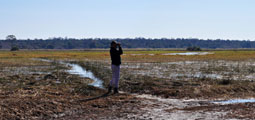
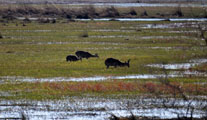
We start with the eastern drive along the river.
We see many hippos but all far away.
We also see Lechwes.
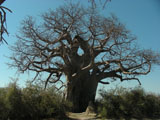
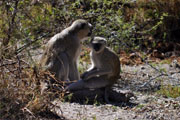
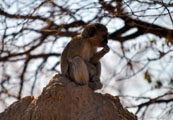
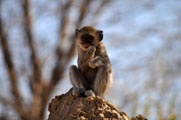
We stop at the Boab lookout.
Again we can spot hippos some of them out of the water.
Vervet Monkeys run around.
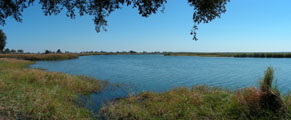
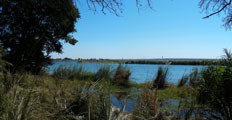
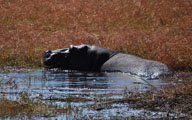
Then we come past a hippo that is having a feed and is reasonably close.
We slowly get closer until it stops eating than go back a bit to restore its "safety zone".
After a while it gets used to us and we can get even closer and take pictures.
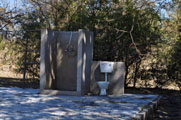
We find a toilet set-up .... seems to be new ... or at least never used .....
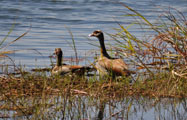
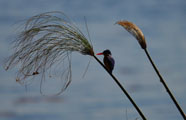
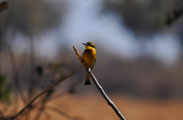
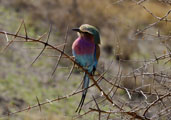
We head further south were we see some pretty birds.
Then we head back north.
When we come past the place where we had seen the hippo it is gone.
As it could be close to the road we drive very slowly and spot it in the bushes maybe 20 m away from the road.
It stops, we stop too.
We wait and it waits too.
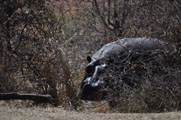
After some 10 minutes of inactivity Susi carefully gets out of the OKA and walks a bit along the road to get a better view of the hippo.
Then the hippo starts walking towards the road so Susi gets back into the OKA and we leave the hippo alone.
Next we visit the waterhole to the east.
The area just recently burnt and is all black.
We see fresh elephant tracks on the track and shortly after see three large male elephants walking in direction of the river.
When we reach the waterhole it is dry.
We decide tow walk to the pump and have a look what is wrong.
As we reach the pump a bakkie arrives and people jump out to install a new pump.
Then we leave the Mahango NP and drive towards Ngepi Camp.
What we cannot know is that the southern track to the camp goes through a swamp.
A few weeks earlier this all must have been still under water ...... all at the end right in front of the camp there is one really tricky section but we make it.
We are lucky and get a site for the night without reservation.
It is a great place, all made with a lot of love to the detail.
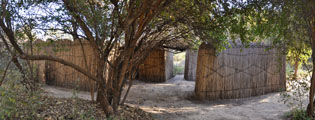
The amenities are open-air and well maintained.
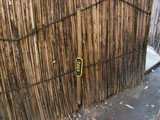

This is an open door ............ and this is a closed door .....

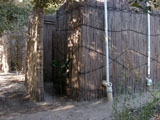
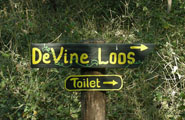
The toilet still has a lid and all works correctly.
We are surprised.
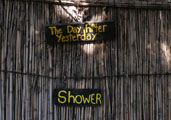
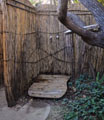
The showers have hot water, heated with solar.
Their sense of humour is great.
Here a few examples:
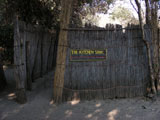
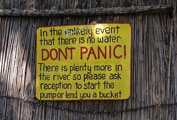
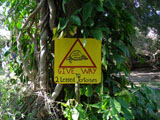
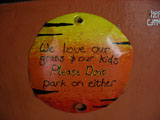
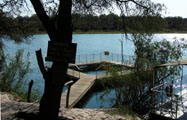
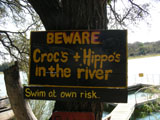
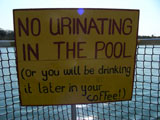
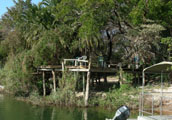
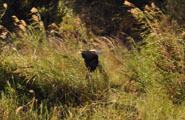
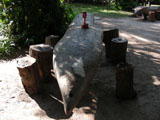
The viewing platform right beside the pub ....
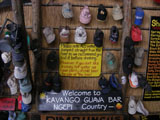
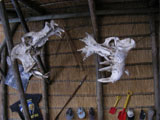
... and the well-stocked bar ....
On Wednesday morning we drive back to the B8, the Trans-Caprivi Highway, on a different track then we came, a better one, suitable for 2WD ...... or at least one, where the sandy sections are marked!
On the way out we are stopped by a boy with a "donation paper", this time for a trip to Etosha ....... that is a bit far-fetched .....
And the writing is the same as on the paper at Popa Falls .....
And the "official seal" is added to the donations list with staples ........ hmmmmmm ...... looks like our suspicion was right .....
A bit further up the road another boy stops us with a "donation paper" ..... same hand writing ...... now we are convinced that a clever person is behind this all and all "donations" go to the same "project" that has nothing to do with any education projects or so.
At the Kavango River Bridge we are stopped at the police check point.
They want to see the driver's license, so we give them or well done fakes.
They walk around the OKA and ask us to get to the side of the road .........
They criticize that we don't have a reflecting strip ... and that the tyres are too bad, not enough thread on it.
Ruedi gets out of the car and starts discussing with them .....
Yes, we will buy a reflecting strip at the next service station .....
No, they are regroovable and still have enough rubber ...... and we are on the way to Zambia and don' want to waste our last good spare ...... etc etc
After a while the police officer gives in and let us go.
In many sections of the bitumen road through the Caprivi Strip (B8) there is an 80 km/h speed restriction because of the elephants.
And we actually see elephants walking parallel to the road!
We drive all the way to Susuwe and fetch the permit for the Bwabwata National Park (Caprivi Game Park).
The drive south into the park goes through some deep sandy sections.
Then we reach the Nambwa Community Camp and get the last free site.
We decide to camp right outside of the camp on a flat section and this way leave the last site to somebody else.
Then it is time to visit he horse shoe.
The sand gets even softer and Ruedi has to lower the tyre pressure to sand.
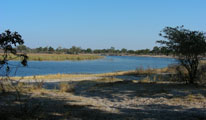
We see some cars along the side of the road.
Then we see why ......
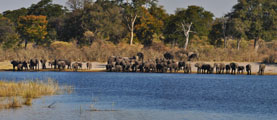

Some 45 – 50 elephants are drinking, some of them are grown-ups, some babies, some youths .....
After they leave we re-park the OKA closer to the river and have an early sundowner.
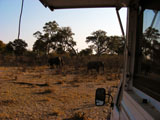
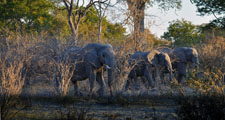
Then we hear elephants behind the OKA.
We watch .... they watch ...... then we decide to close the door and the window so they cannot smell our fruits .....
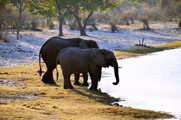
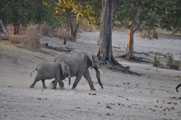
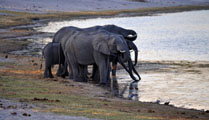
They go for a drink and a younger one joins them from further down the lagoon.
They must know each other as they peacefully walk away together ........
When we see the next larger group of elephants arriving we decide to get to the other side of the lagoon so we are not "obstructed" by elephants when we have to return to the camp ........ elephants can take their time at the water ......
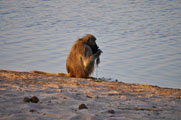
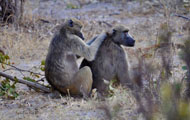
Baboons are also having a drink and eat some of the grass that has been washed ashore.
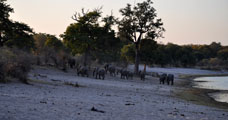
After the group of elephants has had its drink we slowly make our way back to the camp.
We have to drive slowly and watch out for elephants.
They are everywhere!
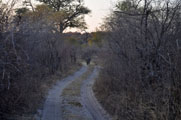
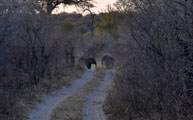
Then some elephants block out track ..... we wait ........
Every time we think that now the last one has passed another one appears.
Then it looks like the last one has gone to the water.
We crawl past and see them eating and a mother with the baby drinking.
If we pass her now we will pinch her between the water and the track ...... slowly slowly we pass her and very carefully watch what she does ......
Ruedi lets the OKA walk on its own and has the foot ready on the gas just in case he has to quickly leave the scene ......
Then we hear a trumpeting sound right on the other side of the OKA .....
Ruedi puts the foot down and we dart away ..... as good as you can "dart" on sand in 4 lows!!!!
We had not seen the rest of the group and had actually driven right into a larger group of female elephants with their young ones ...... but all went well and they seem to be used to stupid tourist in cars too ......
We head back to the camp and settle down with some more great memories.
During the night we can hear the hippos grunting but when we get the flash light
On Thursday morning we head back towards the main road following the tracks closest to the water.
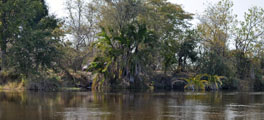
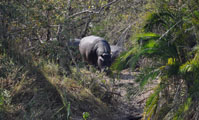
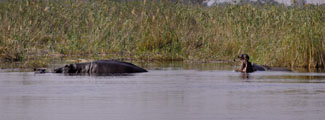
We find a spot where there are a lot of hippos. First we only see a few in the water, then we realise that they are on the nearby island ......
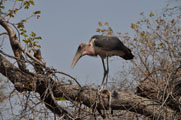
Next we see some ugly birds ..... They look like a mixture of a stork and a vulture .......
When we check the bird book we see that they are actually Marabou Storks ..... and they feed on carcasses and rubbish!
So we were pretty close with our guess.
Next we see a group of vultures circling and the wind brings a disgusting smell of dead meat towards us, but we cannot spot the kill.
Ruedi even carefully heads out into the bush a bit but has no success ..... .
It only results in the vultures sitting down on a tree and making it close to impossible to find the carcass especially as exactly now the wind dies down too and the stench disappears.
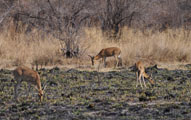
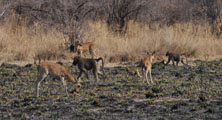
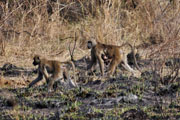
Lechwes and Baboons also have their feed on a freshly burnt patch.
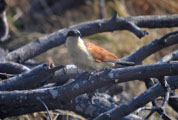
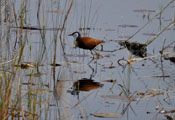
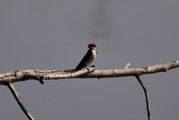
Many birds can be viewed too.
Back on the B8 we head east.
Shortly after we reach a police check-point.
The officer asks for the passport and Ruedi hands him the certified copy of the first page of the Australian Passport.
The officer is a bit surprised and asks what this is.
When Ruedi replies that it is a certified copy of his passport and he does not usually hand out the original passport the police officer understands and accepts it.
Again we realise that Namibian Police are very understanding and patient.
We leave the B8 and head south on the D3511runtil we reach the Mudumu National Park.
We deviate to Hippo Pool but cannot see any hippos, just lots of tracks.
We decide to have lunch and see if any hippos come out of the water.
But all searching and waiting does not help, they are not near the water's edge.
So we pack up again and when we exit the camper see that we just missed a large group of elephants that had come for a drink some 30 - 40 meters close to us.
We had not heard a thing ...... amazing for such large animals!
We continue on and reach the ranger station where Ruedi come just in time to give them a hand with pumping a tyre.
The ranger tells Susi that there is just one group of buffalos in the park and he does not exactly know where they are, but there are plenty of elephants. But we should head down to Mamili (Nkasa Lupala) National Park, there we would find many buffaloes.
So we continue on along the water.
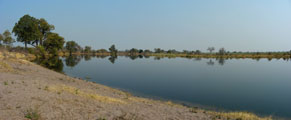
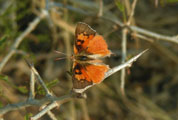
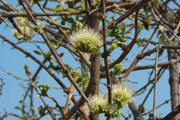
We now see that Mudumu NP has 3 campsites (flat areas with a long drop toilet ......) that are situated right along the water and are really worth staying a bit.
But we want to stay at Mamili NP so we continue on.
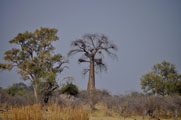
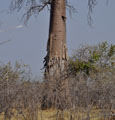
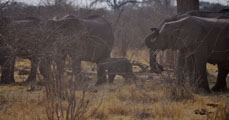
There are elephants everywhere!
The trees show marks of destruction too.
After campsite 3 at Hippo Pool we "bump" into groups of 15 -20 female elephants with babies and young ones with maybe 5 minutes interval in between.
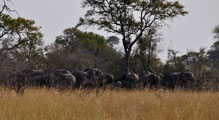
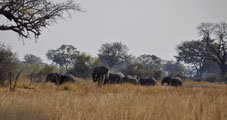
But we have learned from the last few "encounters" and now wait just that wee bit longer until really all elephants have crossed the road before we continue on driving.
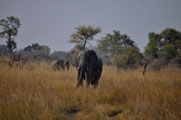
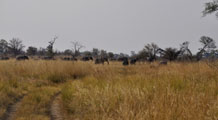
Then we gets stuck between two groups and one female is not really certain if she wants to cause rouble or not, flaps with her ears and comes closer and closer.
Ruedi gets a bit nervous and starts closing the window ...... but then the last young one of her group crosses the track and she is happy and leaves us alone.
Then we leave the park and drive the short distance to Sangwali where we turn off towards Mamili National Park.
The track is sandy and we reach a village.
There we follow the sign for the park and reach a bridge ........ on the map it said "new high pole bridge" .....
Well, it is news and it has poles but it is made of small trees and will never carry more than max. a small bakkie ........ it also has a gate on it and the locals that are busy there tell us that the bridge is closed.
They also tell us that must drive through the river beside the bridge.
Ruedi has no interest in this as it is sandy and we don't feel like getting stuck in river silt.
So we turn around and try the eastern entry past the Malengalenga Village but the tracks both we see on Tracks4Africa have not been driven for a long time and end at a swamp with high reads .... and it is getting dark ...... and the tension in the driver cabin increases ........
So very disappointed and frustrated we decide to give up and to find a spot for the night.
We would have loved to visit this park but we have to see the limits of where we can get with the OKA and driving through swamps is definitively not within them.
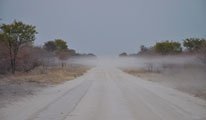
By now the wind has died down and the dust is not blown away anymore ... it looks like fog ....
On Friday morning we transfer go Katima Mulilo to get organised for our change over to Zambia.
As we cannot get the Zambian currency here we decide to buy some US$ which doe to the tough laundry washing laws is quite a time consuming exercise. Besides that the computer is playing up and the lady asks us to be back a 3 PM to pick up the paperwork.
We are at the bank five minutes early, just before 3 PM ...... and the bank is closed ...... looks like they are run at African time not Namibian time .....
Luckily they will be open tomorrow too so we will be back.
We receive some overlander neighbours with a LandCruiser with German number plates, Peter and Traudel.
When we head over for a chat we find out that this morning they had just said goodbye to Thomas and Lilli Kreutziger, who we are supposed to meet in Livingstone in a few days.
The world is small!
Note to the reader:
Thomas Kreutziger is the previous owner of Alu-Star, the company that build our back section. He flew to Australia from Tanzania in 2006 to help finish our vehicle.
We have a very pleasant evening and exchange infos and guide books, we from Namibia and they from Kenya, Tanzania, Zambia and Malawi.
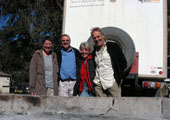
On Saturday morning, July 30, we have Peter and Traudel over for breakfast as it is still quite cold and windy outside.
Then it is already time to say goodbye as they have to be in Windhoek in one week.
We head into town and visit the bank.
The lady at the counter is very happy to see us.
It looks like the missing signature would have caused a lot of trouble for the bank .....
Then we walk through town to find some reflecting tape ..... the one that the police officer had criticized the other day ......
(Peter had said that other African countries also want it on the vehicles.)
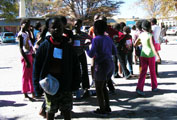
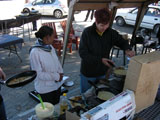
There is a lot of activity in town and every so often police sirens can be heard.
Groups of children and adults wait for something ...... Susi ask them what for?
The private school of Katima Mulilo is having a fund-raiser marathon.
The small kids (age 7 to 12) run 1 mile and all other age groups run 12 km, even he "50 and older" group ......
The first price is quite large for Namibian standards (800 N$ = approx. 120 AU$) and attracts a lot of people.
Pancakes, cold drinks, and sweet cakes are sold and there is a lot of activity.
Always when the first runner of the next group comes into town a police car with siren comes first to clear the way through the busy main street.
We like the atmosphere in Katima Mulilo much better than the one in Rundu.
They are both border towns but Katima Mulilo is much more relaxed and friendly.
Then it is time to head back to the camp and get some work done.
We still have some data allowance on our SIM Card and want to use it before we leave Namibia.
We liked Namibia very much and sadly did not have enough time to see the north ......
Should there be a "next time" it will for certain include Namibia!
And this is the end of this journal.
| 
![]() Created by Level X Webdesign
Created by Level X Webdesign